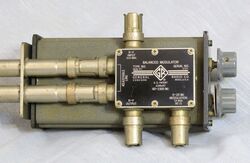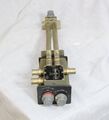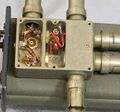1000-P7: Difference between revisions
Jump to navigation
Jump to search
No edit summary |
No edit summary |
||
| Line 19: | Line 19: | ||
The '''General Radio ''' was introduced in 1954 Catalog N and remained available through Catalog R 1963. | The '''General Radio ''' was introduced in 1954 Catalog N and remained available through Catalog R 1963. | ||
The Type 1000-P6 is an accessory | The Type 1000-P6 is an accessory modulator for oscillator frequencies between 60 and 2500 MHz. It uses two 1N21B microwave diodes as part of the modulator. The 1000-P6 uses three controls that require and oscilloscope to properly adjust. Using these controls the modulator provides am, double sideband suppressed carrier and pulse type modulation. The phasing adjustment is two parts, a fine control knob and coarse control by extending or retracting the "trombone" line. | ||
==Specifications== | ==Specifications== | ||
Revision as of 21:14, 31 March 2024
The General Radio was introduced in 1954 Catalog N and remained available through Catalog R 1963.
The Type 1000-P6 is an accessory modulator for oscillator frequencies between 60 and 2500 MHz. It uses two 1N21B microwave diodes as part of the modulator. The 1000-P6 uses three controls that require and oscilloscope to properly adjust. Using these controls the modulator provides am, double sideband suppressed carrier and pulse type modulation. The phasing adjustment is two parts, a fine control knob and coarse control by extending or retracting the "trombone" line.
Specifications
- Carrier Frequency Range: The useful carrier-frequency range is 60 to 2500 MHz
- Modulation-Frequency Range: 0 to 20 MHz. For pulsing, the rise-time contribution is less than 20 ns
- Impedance: source and load impedances are 50 Ω, The impedance at the modulation input is 50 ohms ±5%
- Bias: internal battery, adjustable 0 to 3 V (2 D-cells)
Links
Photos
-
-
-
-
-
-
-
-
Battery Box 2 D-cells
-
-









